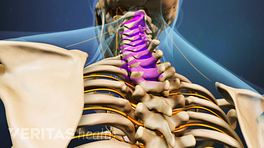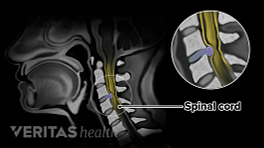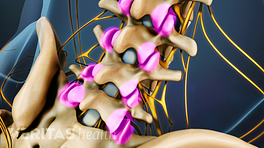Spinal degeneration in the neck is called cervical spondylosis. A person’s risk for this condition increases with age and natural wear and tear. It can also be accelerated by an injury.
In severe cases, spondylosis can cause myelopathy, which is spinal cord compression that results in neurological deficits. When myelopathy is caused by cervical spondylosis, it is called cervical spondylotic myelopathy. It can be caused by many factors, such as degenerating discs and facet joints, enlarged bone spurs, and ligament thickening.
Cervical spondylosis with myelopathy may worsen over time. If the spinal cord becomes compressed within the cervical spine, pain or neurological deficits, such as numbness or weakness, may be experienced in the arms, legs, or anywhere below the level of compression.
Treating myelopathy typically requires surgery to decompress the spinal cord and prevent neurological deficits from worsening.
In This Article:
- Cervical Spondylosis with Myelopathy
- Cervical Spondylosis and Cervical Myelopathy Symptoms
- Diagnosis of Spondylosis with Cervical Myelopathy
- Cervical Myelopathy Treatment
- Cervical Spondylosis with Myelopathy Animation










